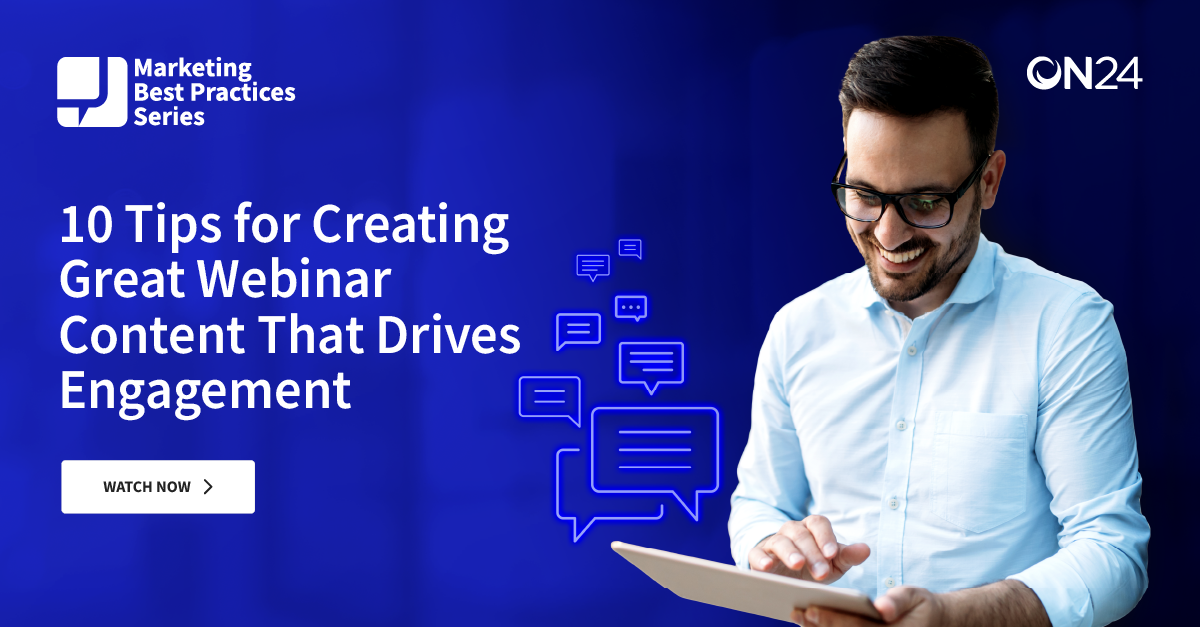Many of life’s everyday elements have returned to “normal.” Most people can meet face-to-face, catch up over dinner, and enjoy the activities that matter most to them.
However, for B2B marketers, things have changed considerably. Buyers conduct more of their research online and, as a result, PwC estimates that spend on B2B trade shows will remain below 2019 levels for years to come.
But the cost savings in lower event spend doesn’t translate to more opportunities elsewhere. As usual, marketers have seen targets increase while budgets either remain in place or are cut. Audience expectations keep rising faster than most companies can meet them. To top it all off, the amount of tech available is simply overwhelming.
So, what should B2B marketers do to improve their B2B marketing?
Below are a few highlights from the Power Up Summit. Learn about how to improve your B2B marketing here and now, with invaluable B2B marketing advice. For the rest, sign up to watch the sessions on demand.
#1: Make your personalization meaningful — but don’t try to personalize everything

If you’ve ever done any email campaigns as part of your B2B marketing scheme, chances are the first thing you learned was how to insert someone’s first name into the content. At a later stage, you may have created emails that were automated to be triggered at a particular moment.
But for Caroline Berith, director of demand generation at Canto, this can lead to a limiting mindset — namely, that “marketers equate personalisation with automation” rather than viewing it as a way to offer meaningful content and experiences.
“What we should be doing is thinking about where our buyer or customer is in that self-guided journey, and how to create and serve marketing that addresses their needs in that moment.
That’s where we can also have a bit of fun with our marketing — making our material and creative really stand out and speak to our audience, so it gets their attention, meets their needs and ultimately guides them down that path towards, in many cases, a purchase.”
In fact, surface-level and irrelevant personalization can irritate buyers. This is a particular source of frustration for Leanne Chescoe, senior marketing manager for EMEA at Demandbase.
“I am frequently on the receiving end of lots of emails which while ‘technically’ personalised — in that they use my name and the name of my company, Demandbase — they are totally irrelevant and do nothing but irritate me.
“And as an example of how irrelevant they can be, I often get such impersonal emails in my inbox and messages on LinkedIn — that actually are sent by our competitors!”
Kate Doyle, senior marketing manager at Adobe, noted that the best personalization should be almost invisible.
“I think that if you notice personalization, it’s bad personalization. You don’t notice great personalization — it should be in the background, and it should make your buyer interested, and then you’re actually grabbing their attention.”
But personalization doesn’t mean reinventing each element for every touchpoint. For ON24’s EMEA Marketing Director, Emily Smith, good personalization doesn’t mean each asset is completely unique.
“We need to remember that rarely do customers convert after a single event — especially in B2B marketing, where each buyer will engage with multiple different touchpoints.
“Where we can personalize our marketing — and allow buyers to personalize journeys by themselves as they “choose their own adventure” — is in the options we surface. That way, it’s the sum of the touchpoints and the journey as a whole that’s personalized, rather than the individual elements.”
#2: Stay clear of chasing lead numbers in demand generation — and make sure your metrics matter

“So, how many leads did you get?” That’s a question that B2B marketers hear far too often.
But even if this question comes up, there’s no point in simply chasing a raw number of new names and form fills if none of these turn into revenue. Informative B2B marketing advice has always strongly discouraged this. And, for Jenna Chambers, Head of EMEA Partnerships at Terminus, this isn’t what driving demand should look like.
“If you actually think about what demand generation should be, it’s exactly what it says — generating real demand. It shouldn’t be about just driving large numbers of leads, focused on sucking in as many contact names and email addresses as possible…
There’s no point in gaining those net-new contacts if they have no genuine need for what we’re offering — we tie our precious sales teams up making calls to people who aren’t ready to, or don’t want to, engage with us.”
At Reachdesk, the desire to escape such a flawed approach is strong enough that the term MQL has even been banned as a volume approach often suggests important steps have been missed. According to the company’s Global VP of Marketing Christy Steward:
“If you’re just looking at those volumes, chances are that you haven’t done the foundational work that’s essential to creating quality opportunities. Instead, people should make sure they’ve understood their buyer and their needs, building out their ICP and identifying target accounts — and then make sure the marketing you are doing aligns with that.”
However, avoiding chasing raw lead numbers doesn’t mean that marketers should avoid setting goals in their B2B lead generation efforts. LeadScale’s Managing Director, Chris Parry, recommends to set KPIs that are based on real impact.
“What B2B marketers should be doing is speaking to sales and getting their feedback on what exactly makes for a good opportunity and where there is the largest chance for revenue. From that, marketers can then be much more specific and accurate in defining and measuring their impact.”
#3. Drive active engagement rather than passive consumption for your buyers

When thinking about how to improve a B2B marketing scheme, it’s important to remember that success doesn’t come from simple passive messaging. Buyers are people who want to feel connected — and when they are online, there’s a lot of potential distractions and alternatives that are just a click away.
That’s why Drift focuses on driving conversations with buyers across channels — which for Andra Barbuceanu, Head of Marketing EMEA, is a tactic that can be especially valuable for virtual events.
“When events are just passive, the viewers on the other side of the screen feel that there’s somewhat of a wall in between them and the presenter. There’s no way of communicating or interacting with the presenter or the experience.
“That’s why at Drift, we’re all about driving conversations. We need to put the customer and audience first and stay connected with them at all times. It’s the only way to keep the engagement levels up.”
In addition to using conversational engagement tools like Q&A or chat, B2B marketers should also think of other ways to interact with audiences. These interactions can also help to surface first-party data useful for qualifying buyers and personalising experiences. A tip from Gudfinnur “G” Thorsteinsson, Event Marketing Manager at Playable involves thinking not as a marketer but as another profession entirely:
“When you’re designing your online event experience, think like a game designer. What can you add into the online experience in order to keep the audience engaged with you rather than going to their inbox or social media? So for a quiz, that might be a survey relevant to your audience with personalised results.”
And given that buyer journeys seldom consist of a single touch, marketers should look for ways to drive engagement through personalized outreach before any event or flagship campaign launch. This is something that Vidyard uses to great effect, as told by the firm’s Senior Marketing Manager, Val Hamilton:
“We’ve found our most successful and engaging events are the events where we tailored invites and hype material to the audience’s personas and departments. We took the time to hand-pick marketing talk tracks, speakers, and partners to our marketing audience and we did the same for our sales audience. Not only does this tactic help us to increase overall signups, we also drive more attendance day-of and more engagement within our sessions.”
#4. Focus on driving engaged and interested contacts to sales — and help sales to keep on engaging

To make a real impact, B2B marketers need to ensure that anything they give sales helps them to close.
But, just as it doesn’t make sense to chase raw lead volume simply, marketers also need to ensure sales only gets the leads that are likely to convert. Not only that, but B2B marketers should also provide sales with intelligence on prospects and tools to help reps start relevant and meaningful conversations. This is an issue seen frequently by Elysia Plummer, SDR Team Lead at Outreach:
“Sometimes leads are sent to sales too early, for example as soon as they’ve filled in a form on the first touch — but with no clarity on what needs to happen next. A lot of money goes from marketing to get leads, but there’s a lot of inaction from them.
Too often after that initial touch point, often they fall to the wayside and the sparkle is lost. At that point they just become a regular cold lead that you have to warm up from scratch. That means it’s really important to build processes that help reps keep on top of these contacts in an effort to keep them engaged.”
Given that no buyer is forced to answer the phone or reply to a sales email, B2B marketers should switch from a mindset of simply sending buyer details to sales, to one that respects their own pace and buying journey. This was a point raised by Simon Roberts, strategic enterprise account director at Integrate:
“Today it’s more important than ever to acknowledge and respect where the buyer happens to be in their journey and adjust to them.
“So what marketing needs to do to respond to that is to set sales teams up to succeed and provide experiences that support the buyer as sales tries to connect with them. You need to provide them with the right tools and content that allows them to be relevant and useful when they connect with buyers.”
Finally, identifying a buyer as “sales-ready” — aside from a prospect reaching out directly — means being able to measure whether they have progressed sufficiently in their buying journey. Unfortunately, not enough B2B marketers are using tools such as lead scoring to do so. Only 23% take advantage of lead scoring data, according to research cited by Act-On’s EMEA Marketing Manager, Naila Basit. But there also needs to be a change in how sales and marketing work together.
“There needs to be a mindset shift that changes how we look at sales and marketing. We shouldn’t see ourselves as separate teams — and at Act-On we are now a single revenue team. That’s been a big change for us, but we now have one target and work to achieve the same results.”
Find out more
The above takeaways are just a fraction of the tips, tricks and advice that B2B experts shared during the Power Up Summit. To fully power up your marketing, sign up now to watch all the sessions on-demand.

